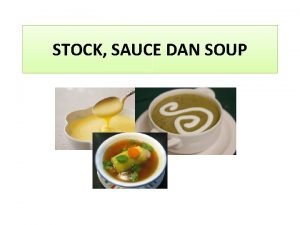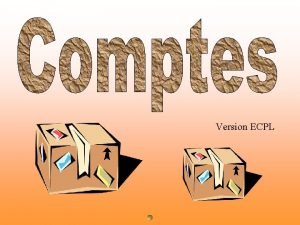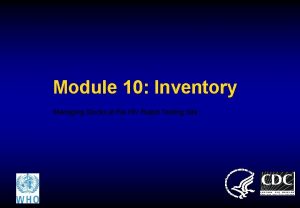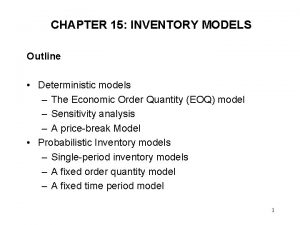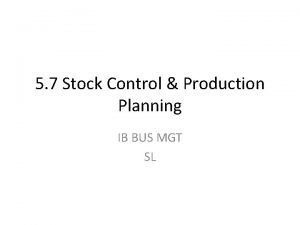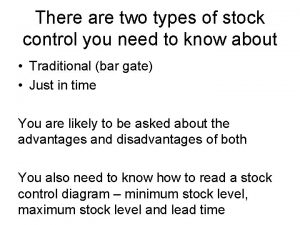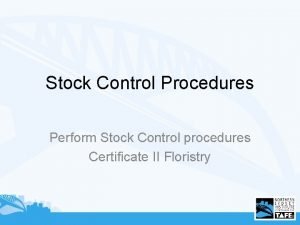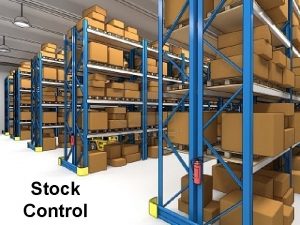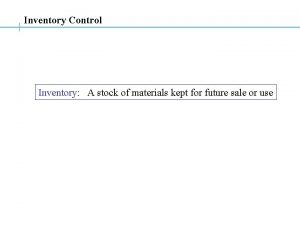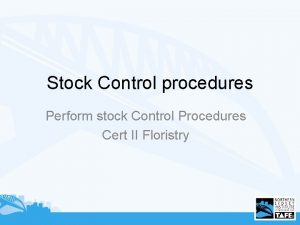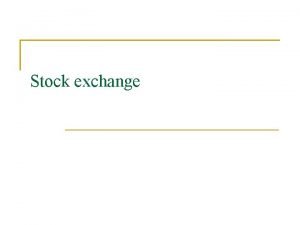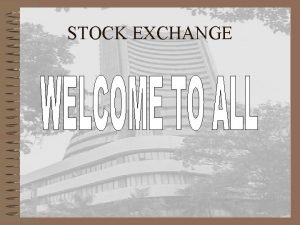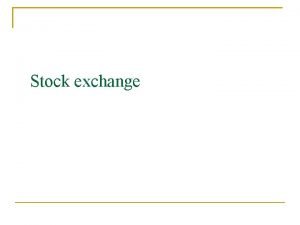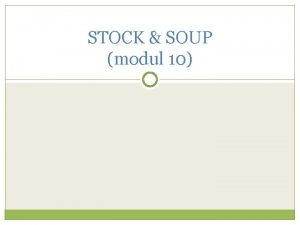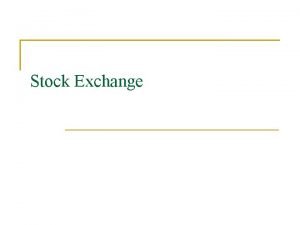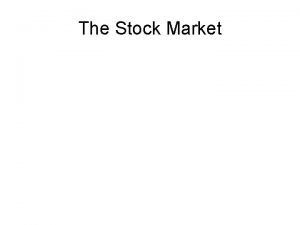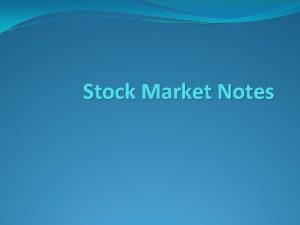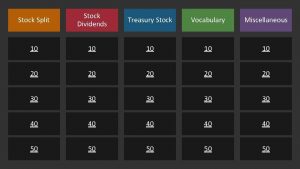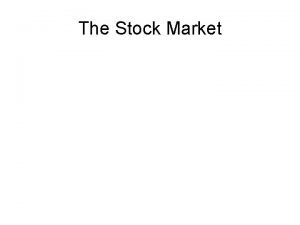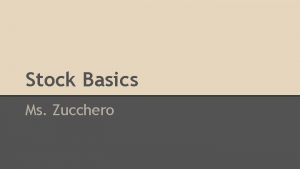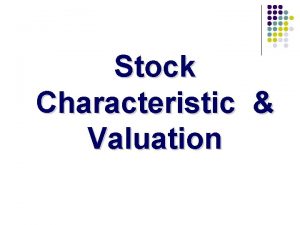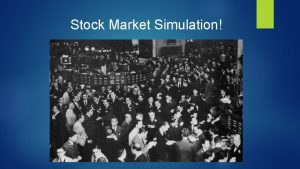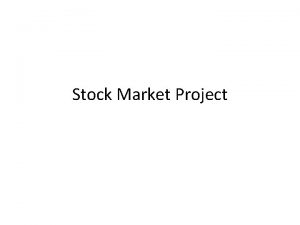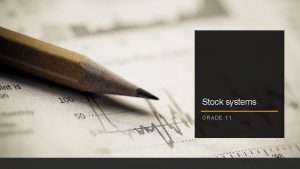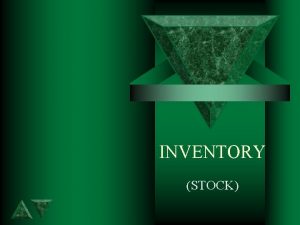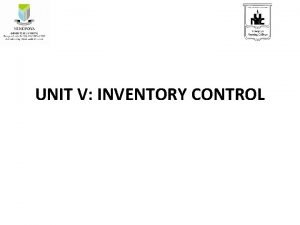Inventory Control Inventory Inventory is the stock of


























- Slides: 26

Inventory Control

Inventory • Inventory is the stock of items kept in hand to meet the fluctuating Demand. • A Certain level of Inventory is maintained that will help in fulfilling the anticipated demand.

Types of Inventory • Raw Materials • This type of inventory includes any goods used in the manufacturing process, such as components used to assemble a finished product. • Raw materials may also include partially finished goods or materials. • For example, for an orange juice company, oranges, sugar and preservatives are raw materials; while for a computer manufacturer, chips, circuit boards and diodes are raw materials.

• Work-in-Process • Work-in-process inventory items are those materials and parts that are waiting to be made into something else. • These may include partially assembled items that are waiting to be completed.

• Finished Goods • Finished goods are any products that are ready to be shipped out or sold directly to customers, including to wholesalers and retailers. • Finished goods may be waiting in a storage area or on a shop floor. • If the amount of inventory of finished goods increases faster that the amount of raw goods and work-in-process goods, then production may need to slow down until more finished goods are sold

• Other Types of Inventory • Maintenance, repair and operating inventory are all the items an organization needs in order to operate, such as office equipment, packing boxes and tools to repair equipment.

Objectives of Inventory Management • To minimize the investment on inventory. • To minimise the idle time by avoiding stock outs and shortages. • To minimise carrying Cost. • To avoid obsolescence of inventory.

Functions of Inventory Management • To meet the anticipated Demand (To meet uncertainty in demand). • To smooth Production requirements (Sudden breakdown of machine). • To protect against the stock outs. • To provide protection against the Price increases. • To take advantage of Quantity discount

Under stocking of Inventory • Understocking of inventory results in cost incurred when an item is out of stock. • It includes the cost of lost production during the period of stock out. • It also includes the extra cost per unit which might have to be paid for an emergency purchase.

Overstocking of Inventory • Overstocking results in the cost incurred due to : • Storage Cost • Obsolescence • Shift in demand • Opportunity Cost of capital.

Analysis of inventory • http: //www. sparepartsmanagement. co. in/Inv entory%20 analyses. html

Costs Involved in Inventory • Inventory Carrying Cost (or Holding Cost) – Cost of storing items in storage. • These costs vary with level of inventory and length of time inventory is held. • Includes operating costs, record keeping etc.


• Ordering Cost – Costs of replenishing the cost of inventory. • Expressed as Rupees per order. • Independent of Order Size. • These costs vary with the number of orders made. • Includes shipping costs, inspections costs etc.



• Shortage or Stock-out Costs – Cost associated with insufficient inventory. • Loss of sales • Penalties

Review Systems • Tracking inventory is an essential part of business operations for any company that sells tangible goods. • The system used to track inventory for accounting and ordering purposes. • Two Methods are Continuous Review System and Periodic Review System.

Continuous Review System • Continuous inventory review, also known as perpetual review, involves a system that tracks each item and updates inventory counts each time an item is removed from inventory. • For example, a retailer may use bar code scanners to record customer purchases and update inventory counts every time a cashier scans a product code.

• Whenever the Inventory decreases to a predetermined level (the re-order point), an order is placed for fixed amount to replenish the stock. • The fixed amount is Economic Order Quantity (EOQ). • Its magnitude is fixed at a level which minimises the Carrying cost, Order cost and shortage cost

Economic Order Quantity Model • Economic Order Quantity is the quantity ordered when inventory decreases to the reorder point. • The purpose of the EOQ Model is to decide the Optimal Order size that will minimise the Total Inventory Cost.


Assumptions of EOQ Model • The demand rate is constant and is known with certainty. • No constrains are placed on the size of each lot. • The only two relevant costs are inventory holding cost and the Ordering Cost. • No shortages are allowed. • Decisions for one item can be made independent of decisions for other items. • The Lead time is constant and is known with certainty.

Lead Time • The Time Period between placing an order and receiving the Order is Lead time

Reorder Point • Inventory level of an item which signals the need for placement of a replenishment order, taking into account the consumption of the item during order lead time.

 Stock control e flow control
Stock control e flow control Long-term debt preferred stock and common stock
Long-term debt preferred stock and common stock Teknik pengolahan makanan dalam pembuatan stock adalah
Teknik pengolahan makanan dalam pembuatan stock adalah Preferred stock characteristics
Preferred stock characteristics Stock initial
Stock initial Stock card inventory
Stock card inventory Deterministic and probabilistic inventory models
Deterministic and probabilistic inventory models Is inventory a stock
Is inventory a stock Inventory control definition
Inventory control definition Stock control chart ib business
Stock control chart ib business Two types of stock
Two types of stock Stock control procedures
Stock control procedures Hát kết hợp bộ gõ cơ thể
Hát kết hợp bộ gõ cơ thể Slidetodoc
Slidetodoc Bổ thể
Bổ thể Tỉ lệ cơ thể trẻ em
Tỉ lệ cơ thể trẻ em Voi kéo gỗ như thế nào
Voi kéo gỗ như thế nào Tư thế worm breton
Tư thế worm breton Chúa yêu trần thế
Chúa yêu trần thế Các môn thể thao bắt đầu bằng từ đua
Các môn thể thao bắt đầu bằng từ đua Thế nào là hệ số cao nhất
Thế nào là hệ số cao nhất Các châu lục và đại dương trên thế giới
Các châu lục và đại dương trên thế giới Công thức tiính động năng
Công thức tiính động năng Trời xanh đây là của chúng ta thể thơ
Trời xanh đây là của chúng ta thể thơ Mật thư tọa độ 5x5
Mật thư tọa độ 5x5 Phép trừ bù
Phép trừ bù Phản ứng thế ankan
Phản ứng thế ankan


